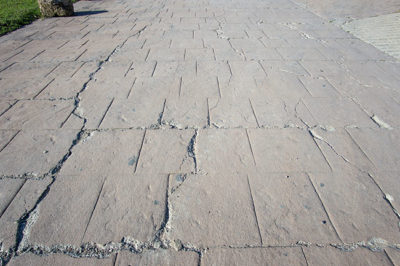How to Fix Cracks in Concrete
 Concrete cracks are very common and there are several causes for this. As a homeowner, you want to save money by repairing smaller cracks yourself. For larger cracks, it’s best to have these checked and repaired by a professional.
Concrete cracks are very common and there are several causes for this. As a homeowner, you want to save money by repairing smaller cracks yourself. For larger cracks, it’s best to have these checked and repaired by a professional.
What Causes Concrete to Crack?
- Concrete mixture. Cement and aggregates are mixed with water to make it usable. Often too much water is added to the mixture to make it easier to use. If too much water is added, the slab will shrink as the excess water evaporates and cause cracks to develop. The ratio of aggregate, sand, cement, and water should be correct for the strength required.
- Incorrect curing. As concrete dries, it requires hydration to assist the curing process. Curing can take several days, even weeks and it is important to keep the slab moist during this time.
- No control joints. Control joints or expansion gaps are deliberate cracks caused by positioned spacers when the concrete is poured. This prevents other cracks from forming as the slab shrinks.
- Excessive freeze and thaw cycles. Freezing causes the concrete to shrink and as it thaws, it will expand. If this happens too rapidly, cracks will appear.
- Movement. If concrete is poured onto unstable soil, the ground beneath the slab will shift under its weight. Tree roots are also a common cause of shifting, as are pipes and conduit under the slab. Any movement can easily cause a slab to crack.
Preventing Concrete Cracks
Follow mixing instructions as recommended by the cement manufacturer. If the ground onto which the slab is being poured is loose, it should be compacted and the slab may require steel reinforcement.
You should ensure that the slab remains moist whilst curing. In hot weather, the slab will require water to be added frequently, throughout the day. The longer one continues to keep the slab wet, the better the chances of a perfect curing.
Pay attention to tree root systems around the slab. To counteract the effects of rapid freezing and thawing, it’s better to use sand instead of salt to combat ice in winter. A high-grade sealer will protect the surface against excessive heat during summer.
Fixing Cracks
This is a simple process if you follow these steps correctly.
Step 1: Clean the area thoroughly making sure that there is no grease or oil that will prevent the cement from bonding.
Step 2: Using a chisel, remove all loose debris and gravel from the crack. Widen the crack to help the patching material bond better.
Step 3: Use a brush or vacuum cleaner to remove all dust in and around the crack.
Step 4: If you’re using a pre-mixed filler, cut the nozzle of the bottle and squeeze the filler into the crack. For dry fillers, mix according to instructions and use a trowel to apply. After a few minutes, check the crack to make sure that the concrete patch is tight enough, you may have to add more filler. Smooth off the surface with a trowel.
Step 5: Allow to cure overnight or according to manufacturer specifications and check if more filler is needed. Once the patch has cured sufficiently it’s advisable to seal the repair with a concrete sealer.
Get Professional Help
If you’re good at DIY projects it makes sense to do your home repairs and alterations yourself. However, even the best handyman may need help. For your safety and peace of mind, certain jobs are better done by a professional. If you need a trusted professional for building repairs or alterations, the best people to contact are All-Nu Construction.

